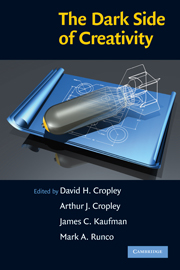Book contents
- Frontmatter
- Contents
- List of Contributors
- 1 The Dark Side of Creativity: What Is It?
- 2 Creativity Has No Dark Side
- 3 Positive Creativity and Negative Creativity (and Unintended Consequences)
- 4 Subjugating the Creative Mind: The Soviet Biological Weapons Program and the Role of the State
- 5 Imagining the Bomb: Robert Oppenheimer, Nuclear Weapons, and the Assimilation of Technological Innovation
- 6 The Innovation Dilemma: Some Risks of Creativity in Strategic Agency
- 7 Early Creativity as a Constraint on Future Achievement
- 8 Boundless Creativity
- 9 Reviewing the Art of Crime: What, If Anything, Do Criminals and Artists/Designers Have in Common?
- 10 Creativity in Confinement
- 11 Creativity and Crime: How Criminals Use Creativity to Succeed
- 12 So You Want to Become a Creative Genius? You Must Be Crazy!
- 13 Both Sides of the Coin? Personality, Deviance, and Creative Behavior
- 14 Neurosis: The Dark Side of Emotional Creativity
- 15 Dangling from a Tassel on the Fabric of Socially Constructed Reality: Reflections on the Creative Writing Process
- 16 Creativity in the Classroom: The Dark Side
- 17 The Dark Side of Creativity and How to Combat It
- 18 A Systems Engineering Approach to Counterterrorism
- 19 Malevolent Innovation: Opposing the Dark Side of Creativity
- 20 Summary – The Dark Side of Creativity: A Differentiated Model
- Index
- References
4 - Subjugating the Creative Mind: The Soviet Biological Weapons Program and the Role of the State
Published online by Cambridge University Press: 05 June 2012
- Frontmatter
- Contents
- List of Contributors
- 1 The Dark Side of Creativity: What Is It?
- 2 Creativity Has No Dark Side
- 3 Positive Creativity and Negative Creativity (and Unintended Consequences)
- 4 Subjugating the Creative Mind: The Soviet Biological Weapons Program and the Role of the State
- 5 Imagining the Bomb: Robert Oppenheimer, Nuclear Weapons, and the Assimilation of Technological Innovation
- 6 The Innovation Dilemma: Some Risks of Creativity in Strategic Agency
- 7 Early Creativity as a Constraint on Future Achievement
- 8 Boundless Creativity
- 9 Reviewing the Art of Crime: What, If Anything, Do Criminals and Artists/Designers Have in Common?
- 10 Creativity in Confinement
- 11 Creativity and Crime: How Criminals Use Creativity to Succeed
- 12 So You Want to Become a Creative Genius? You Must Be Crazy!
- 13 Both Sides of the Coin? Personality, Deviance, and Creative Behavior
- 14 Neurosis: The Dark Side of Emotional Creativity
- 15 Dangling from a Tassel on the Fabric of Socially Constructed Reality: Reflections on the Creative Writing Process
- 16 Creativity in the Classroom: The Dark Side
- 17 The Dark Side of Creativity and How to Combat It
- 18 A Systems Engineering Approach to Counterterrorism
- 19 Malevolent Innovation: Opposing the Dark Side of Creativity
- 20 Summary – The Dark Side of Creativity: A Differentiated Model
- Index
- References
Summary
INTRODUCTION
Weapons of mass destruction (WMDs) invariably carry negative connotations – death and destruction, human suffering, evil intentions, and so on. Yet the process of creativity involved in designing these weapons, which include nuclear, chemical, and biological ones, is, arguably, much more nuanced and less straightforward than simply the intention to cause harm and to commit murder. The motivations for creating WMDs may include a desire to protect one's homeland from external (and internal) enemies, to deter an attack, and consequently, to prevent mass casualties. On the other hand, the weapons' creation may be motivated by the urge to solve purely scientific problems and dilemmas, such as finding ways to battle the plague or creating vaccines for new strands of anthrax or tularemia, for example. It is possible, then, that malevolent and benevolent creativity coexist during the process of WMD creation, which raises the question of how people involved in this process perceive and internalize their actions.
This chapter will explore these questions through the prism of the Soviet biological weapons (BW) program since the end of World War II. Not only was this venture the most massive in scale (and, arguably, ambition) ever undertaken in human history, but it also necessitated a juxtaposition of two seemingly opposite endeavors: the search for and understanding of lifesaving vaccines and the creation of deadly viruses and bacteria capable of killing a great number of people and livestock.
- Type
- Chapter
- Information
- The Dark Side of Creativity , pp. 57 - 71Publisher: Cambridge University PressPrint publication year: 2010
References
- 1
- Cited by



